Indesit IWE 61051 C ECO EU User Manual [cz]

Instructions for use
GB SK RO
English,1 Slovenský,13 Română,25
WASHING MACHINE
Contents |
GB |
|
Installation, 2-3
Unpacking and levelling
Connecting the electricity and water supplies
The first wash cycle
Technical data
CZ HU
Český,37 Magyar,49
Care and maintenance, 4
Cutting off the water or electricity supply Cleaning the washing machine Cleaning the detergent dispenser drawer
Caring for the door and drum of your appliance Cleaning the pump
Checking the water inlet hose
IWE 61051
їнська
Precautions and tips, 5
General safety
Disposal
Opening the porthole door manually
Description of the washing machine, 6-7
Control panel Display
Running a wash cycle, 8
Wash cycles and options, 9
Table of wash cycles
Wash options
Detergents and laundry, 10
Detergent dispenser drawer
Preparing the laundry
Special wash cycles
Load balancing system
Troubleshooting, 11
Service, 12
1

Installation
! This instruction manual should be kept in a safe GB place for future reference. If the washing machine is sold, transferred or moved, make sure that the instruction manual remains with the machine so that the new owner is able to familiarise himself/
herself with its operation and features.
! Read these instructions carefully: they contain vital information relating to the safe installation and operation of the appliance.
Unpacking and levelling
Unpacking
1.Removethewashingmachinefromitspackaging.
2.Make sure that the washing machine has not been damaged during the transportation process. If it has been damaged, contact the retailer and do notproceedanyfurtherwiththeinstallationprocess.
3. Remove the 4 protective screws (used during transportation) and the rubber washer with the corresponding spacer, located on the rear part of the appliance (see figure).
4.Close off the holes using the plastic plugs provided.
5.Keep all the parts in a safe place: you will need them again if the washing machine needs to be moved to another location.
! Packaging materials should not be used as toys for children.
Levelling
1. Install the washing machine on a flat sturdy floor, without resting it up against walls, furniture cabinets or anything else.
2. If the floor is not perfectly level, compensate for any unevenness by tightening or loosening the adjustable front feet (see figure); the angle of inclination, measured in relation to the worktop, must not exceed 2°.
Levelling the machine correctly will provide it with stability, help to avoid vibrations and excessive noise and prevent it from shifting while it is operating. If it is placed on carpet or a rug, adjust the feet in such a way as to allow a sufficient ventilation space underneath the washing machine.
Connecting the electricity and water supplies
Connecting the water inlet hose
1. Connect the supply pipe by screwing it to a cold water tap using a ¾ gas threaded connection (see figure).
Before performing the connection, allow the water to run freely until it is perfectly clear.
2. Connect the inlet hose to the washing machine by screwing it onto the corresponding water inlet of the appliance, which is situated on the top righthand side of the rear part of the appliance
(see figure).
3. Make sure that the hose is not folded over or bent.
! The water pressure at the tap must fall within the values indicated in the Technical details table
(see next page).
!If the inlet hose is not long enough, contact a specialised shop or an authorised technician.
!Never use second-hand hoses.
!Use the ones supplied with the machine.
2

Connecting the drain hose
65 - 100 cm |
Connect the drain hose, without bending it, to a drainage duct or a wall drain located at a height between 65 and 100 cm from the floor;
alternatively, rest it on the side of a washbasin or bathtub, fastening the duct supplied to the tap (see figure). The free end of the hose should not be underwater.
! We advise against the use of hose extensions; if it is absolutely necessary, the extension must have the same diameter as the original hose and must not exceed 150 cm in length.
Electrical connections
Before plugging the appliance into the electricity socket, make sure that:
•the socket is earthed and complies with all applicable laws;
•the socket is able to withstand the maximum power load of the appliance as indicated in the Technical data table (see opposite);
•the power supply voltage falls within the values indicatedintheTechnicaldatatable(seeopposite);
•the socket is compatible with the plug of the washing machine. If this is not the case, replace the socket or the plug.
!The washing machine must not be installed outdoors, even in covered areas. It is extremely dangerous to leave the appliance exposed to rain, storms and other weather conditions.
!When the washing machine has been installed, the electricity socket must be within easy reach.
!Do not use extension cords or multiple sockets.
GB
!The cable should not be bent or compressed.
!The power supply cable must only be replaced by authorised technicians.
Warning!Thecompanyshallnotbeheldresponsible intheeventthattheseregulationsarenotrespected.
The first wash cycle
Once the appliance has been installed, and before you use it for the first time, run a wash cycle with detergent and no laundry, using the wash cycle 2.
Technical data
Model |
IWE 61051 |
|
|
|
width 59.5 cm |
Dimensions |
height 85 cm |
|
depth 53,5 cm |
Capacity |
from 1 to 6 kg |
Electrical please refer to the technical connections data plate fixed to the machine
|
|
|
maximum pressure |
|
Water |
1 MPa (10 bar) |
|||
minimum pressure |
||||
connection |
||||
0.05 MPa (0.5 bar) |
||||
|
|
|
drum capacity 52 litres |
|
Spin speed |
up to 1000 rotations per minute |
|||
|
|
|
|
|
Test wash |
|
|||
cycles in |
Programme 2: |
|||
accordan- |
||||
ce with |
Cotton standard 60°C; |
|||
directives |
Programme 3: |
|||
1061/2010 |
Cotton standard 40°C. |
|||
and |
|
|||
1015/2010 |
|
|||
|
|
|
This appliance conforms to |
|
|
|
|
the following EC Directives: |
|
|
|
|
- 2004/108/EC dated |
|
|
|
|
03/05/89 (Electromagnetic |
|
|
|
|
Compatibility) |
|
|
|
|
- 2002/96/EC |
|
|
|
|
- 2006/95/EC Low Voltage) |
|
|
|
|
||
|
|
|
||
3
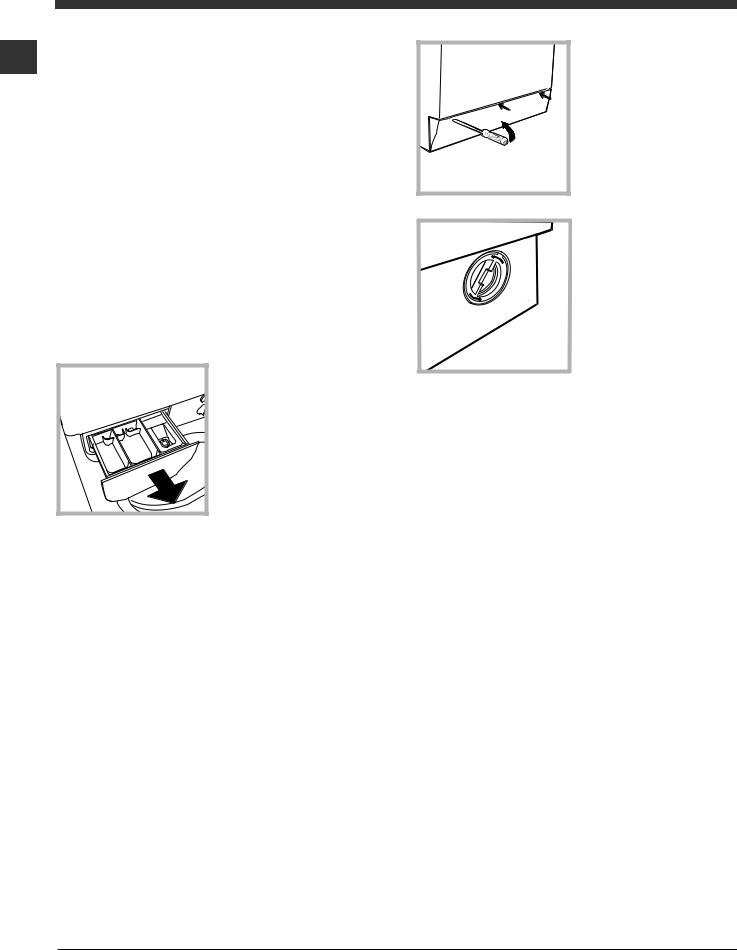
Care and maintenance
GB |
Cutting off the water and electri- |
city supplies |
• Turn off the water tap after every wash cycle. This will limit wear on the hydraulic system inside the washing machine and help to prevent leaks.
•Unplug the washing machine when cleaning it and during all maintenance work.
1. using a screwdriver, remove the cover panel on the lower front part of the washing machine (see figure);
Cleaning the washing machine
The outer parts and rubber components of the appliance can be cleaned using a soft cloth soaked in lukewarm soapy water. Do not use solvents or abrasives.
Cleaning the detergent dispenser drawer
Remove the dispenser by raising it and pulling it out (see figure). Wash it under running water; this operation should be repeated frequently.
Caring for the door and drum of your appliance
•Always leave the porthole door ajar in order to prevent unpleasant odours from forming.
Cleaning the pump
The washing machine is fitted with a self-clea- ning pump which does not require any maintenance. Sometimes, small items (such as coins or buttons) may fall into the pre-chamber which protects the pump, situated in its bottom part.
! Make sure the wash cycle has finished and unplug the appliance.
To access the pre-chamber:
2. unscrew the lid by rotating it anticlockwise (see figure): a little water may trickle out. This is perfectly normal;
3.clean the inside thoroughly;
4.screw the lid back on;
5.reposition the panel, making sure the hooks are securely in place before you push it onto the appliance.
Checking the water inlet hose
Check the inlet hose at least once a year. If there are any cracks, it should be replaced immediately: during the wash cycles, water pressure is very strong and a cracked hose could easily split open.
! Never use second-hand hoses.
4
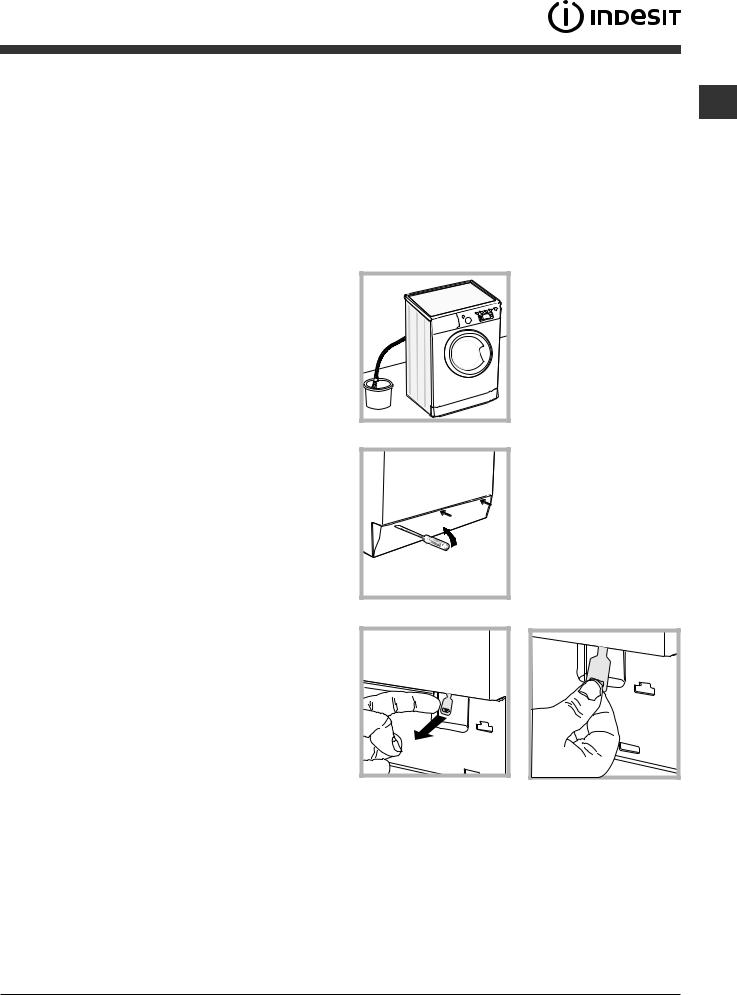
Precautions and tips
! This washing machine was designed and constructed in accordance with international safety regulations. The following information is provided for safety reasons and must therefore be read carefully.
General safety
•This appliance was designed for domestic use only.
•This appliance can be used by children aged
from 8 years and above and persons with reduced physical, sensory or mental capabilities or lack of experience and knowledge if they have been given supervision or instruction concerning use of the appliance in a safe way and understand the hazards involved. Children shall not play with the appliance. Cleaning and user maintenance shall not be made by children without supervision.
•The washing machine must only be used by adults, in accordance with the instructions provided in this manual.
•Do not touch the machine when barefoot or with wet or damp hands or feet.
•Do not pull on the power supply cable when unplugging the appliance from the electricity socket. Hold the plug and pull.
•Do not open the detergent dispenser drawer while the machine is in operation.
•Do not touch the drained water as it may reach extremely high temperatures.
•Never force the porthole door. This could damage the safety lock mechanism designed to prevent accidental opening.
•If the appliance breaks down, do not under any circumstances access the internal mechanisms in an attempt to repair it yourself.
•Always keep children well away from the appliance while it is operating.
•The door can become quite hot during the wash cycle.
•If the appliance has to be moved, work in a group of two or three people and handle it with the utmost care. Never try to do this alone, because the appliance is very heavy.
•Before loading laundry into the washing machine, make sure the drum is empty.
Disposal
•Disposing of the packaging materials: observe local regulations so that the packaging may be re-used.
•TheEuropeanDirective2002/96/EConWasteElectrical and Electronic Equipment, requires that old household electrical appliances must not be disposed of in the normal unsorted municipal waste stream. Old appliances must be collected separately in order to optimise the recovery and recycling of the materials they contain and reduce the impact on human health and the environment.
The crossed out “wheeled bin” symbol on the product reminds you of your obligation, that when you dispose of GB the appliance it must be separately collected. Consumers
should contact their local authority or retailer for information concerning the correct disposal of their old appliance.
Opening the porthole door manually
In the event that it is not possible to open the porthole door due to a powercut, and if you wish to remove the laundry, proceed as follows:
1. remove the plug from the electrical socket.
2. make sure the water level inside the machine is lower than the door opening; if it is not, remove excess water using the drain hose, collec-
ting it in a bucket as indicated in the figure.
3. using a screwdriver, remove the cover panel on the lower front part of the washing machine (see figure).
4.pull outwards using the tab as indicated in the figure, until the plastic tie-rod is freed from its stop position; pull downwards and open the door at the same time.
5.reposition the panel, making sure the hooks are securely in place before you push it onto the appliance.
5
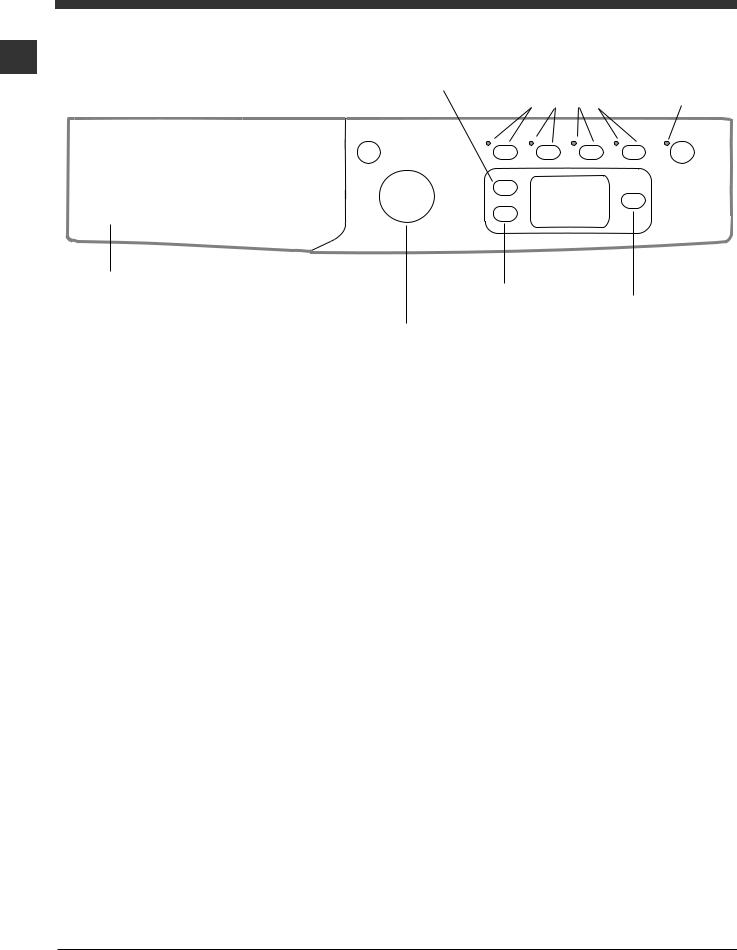
Description of the washing machine
Control panel
GB
ON/OFF |
|
TEMPERATURE |
OPTION |
START/PAUSE |
|
|
|||||
|
buttons with |
||||
button |
|
Button |
button with indicator light |
||
|
indicator lights |
||||
|
|
|
|
|
|
|
|
|
|
|
|
|
|
|
|
|
|
DISPLAY
Detergent dispenser drawer
|
|
DELAYED |
WASH CYCLE |
SPIN SPEED |
START Button |
Button |
|
|
knob |
|
|
Detergent dispenser drawer: used to dispense detergents and washing additives (see “Detergents and laundry”).
ON/OFF button  : press this briefly to switch the machine on or off. The START/PAUSE indicator light, which flashes slowly in a green colour shows that the machine is switched on. To switch off the washing machine during the wash cycle, press and hold the button for approximately 2 seconds; if the button is pressed briefly or accidentally the machine will not switch off. If the machine is switched off during a wash cycle, this wash cycle will be cancelled.
: press this briefly to switch the machine on or off. The START/PAUSE indicator light, which flashes slowly in a green colour shows that the machine is switched on. To switch off the washing machine during the wash cycle, press and hold the button for approximately 2 seconds; if the button is pressed briefly or accidentally the machine will not switch off. If the machine is switched off during a wash cycle, this wash cycle will be cancelled.
WASH CYCLE knob: used to set the desired wash cycle
(see “Table of wash cycles”).
OPTION buttons with indicator light: used to select the available options. The indicator light corresponding to the selected option will remain lit.
SPIN button  : press to reduce or completely exclude the spin cycle - the value is indicated on the display.
: press to reduce or completely exclude the spin cycle - the value is indicated on the display.
TEMPERATURE button  : press to decrease or completely exclude the temperature: the value will be shown on the display.
: press to decrease or completely exclude the temperature: the value will be shown on the display.
DELAYED START button  : press to set a delayed start time for the selected wash cycle. The delay time will be shown on the display.
: press to set a delayed start time for the selected wash cycle. The delay time will be shown on the display.
START/PAUSE button 
 with indicator light: when the green indicator light flashes slowly, press the button to start a wash cycle. Once the cycle has begun the indicator light will remain lit in a fixed manner. To pause the wash cycle, press the button again; the indicator light will flash in an orange colour. If the symbol
with indicator light: when the green indicator light flashes slowly, press the button to start a wash cycle. Once the cycle has begun the indicator light will remain lit in a fixed manner. To pause the wash cycle, press the button again; the indicator light will flash in an orange colour. If the symbol  is not illuminated, the door may be opened. To start the wash cycle from the point at which it was interrupted, press the button again.
is not illuminated, the door may be opened. To start the wash cycle from the point at which it was interrupted, press the button again.
Standby mode
This washing machine, in compliance with new energy saving regulations, is fitted with an automatic standby system which is enabled after about 30 minutes if no activity is detected. Press the ON-OFF button briefly and wait for the machine to start up again.
Consumption in off-mode: 0,5 W Consumption in Left-on: 0,5 W
6
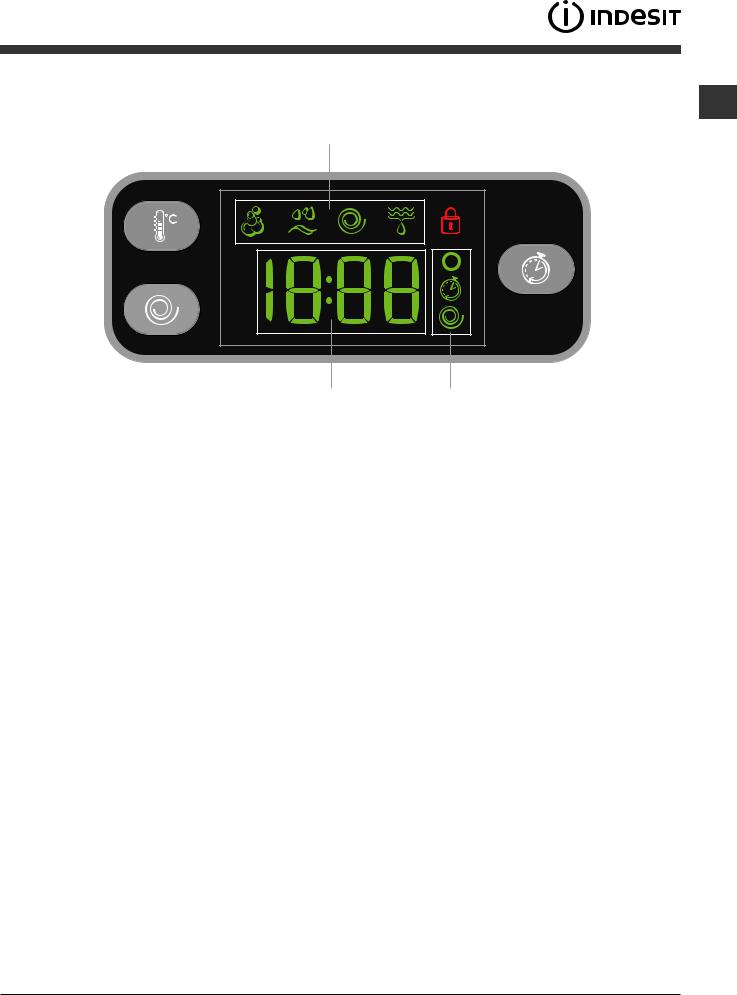
Display
GB
B
AC
The display is useful when programming the machine and provides a great deal of information.
The duration of the available programmes and the remaining time of a running cycle appear in section A; if the DELAY START option has been set, the countdown to the start of the selected programme will appear. Pressing the relative button, the machine automatically displays the maximum temperature and spin speed values set for the selected cycle, or the most recently-used settings if they are compatible with the selected cycle.
The “programme phases” relative to the selected programme and the “programme phase” of the running programme appear
in section B:  Wash
Wash  Rinse
Rinse  Spin
Spin
 Drain
Drain
The icons corresponding to “temperature”  , “Programmed start”
, “Programmed start”  and “spin”
and “spin”  appear in section C from top to bottom: If the
appear in section C from top to bottom: If the  symbol lights up, the display will visualise the set “temperature” value.
symbol lights up, the display will visualise the set “temperature” value.
When a “delayed start” has been set, the  symbol lights up.
symbol lights up.
If the  symbol lights up, the display will visualise the set “spin” value.
symbol lights up, the display will visualise the set “spin” value.
Door locked symbol 
The lit symbol indicates that the door is locked. To prevent any damage, wait until the symbol turns off before opening the
door.
To open the door while a cycle is in progress, press the START/PAUSE button; if the DOOR LOCKED  symbol is switched off the door may be opened.
symbol is switched off the door may be opened.
7

Running a wash cycle
1. SWITCH THE MACHINE ON. Press the  button;
button;
GB the START/PAUSE indicator light will flash slowly in a green colour.
2.LOAD THE LAUNDRY. Open the porthole door. Load the laundry, making sure you do not exceed the maximum load value indicated in the table of programmes on the following page.
3.MEASURE OUT THE DETERGENT. Pull out the detergent dispenser drawer and pour the detergent into the relevant compartments as described in “Detergents and laundry”.
4.CLOSE THE DOOR.
5.SELECT THE WASH CYCLE. Set the WASH CYCLE knob to the desired programme; a temperature and spin speed is set for each wash cycle; these may be adjusted. The duration of the cycle will appear on the display.
6.CUSTOMISE THE WASH CYCLE. Use the relevant buttons:

 Modifying the temperature and/or spin speed. The machine automatically displays the maximum temperature and spin speed values set for the selected cycle, or the most recently-used settings if they are compatible with the selected cycle. The temperature can be decreased by pressing the button, until the cold wash “OFF” setting is reached. The spin speed may be progressively reduced by pressing the
Modifying the temperature and/or spin speed. The machine automatically displays the maximum temperature and spin speed values set for the selected cycle, or the most recently-used settings if they are compatible with the selected cycle. The temperature can be decreased by pressing the button, until the cold wash “OFF” setting is reached. The spin speed may be progressively reduced by pressing the  button, until it is completely excluded (the “OFF” setting). If these buttons are pressed again, the maximum values are restored.
button, until it is completely excluded (the “OFF” setting). If these buttons are pressed again, the maximum values are restored.
! Exception: if the 2 programme is selected, the temperature can be increased up to a value of 90°C.
 Setting a delayed start.
Setting a delayed start.
To set a delayed start for the selected programme, press the corresponding button repeatedly until the required delay period has been reached. When this option is enabled, the symbol lights up on the display. To remove the delayed start option press the
button until the text “OFF” appears on the display.
Modifying the cycle settings.
•Press the button to enable the option; the indicator light corresponding to the button will switch on.
•Press the button again to disable the option; the indicator light will switch off.
!If the selected option is not compatible with the programmed wash cycle, the indicator light will flash and the option will not be activated.
!If the selected option is not compatible with another option which has been selected previously, the indicator light corresponding to the first option selected will flash and only the second option will be activated; the indicator
light corresponding to the enabled option will remain lit.
! The options may affect the recommended load value and/or the duration of the cycle.
7.START THE PROGRAMME. Press the START/ PAUSE button. The corresponding indicator light will become green, remaining lit in a fixed manner, and the
door will be locked (the DOOR LOCKED symbol  will be on). To change a wash cycle while it is in progress, pause the washing machine using the START/PAUSE button (the START/PAUSE indicator light will flash slowly in an orange colour); then select the desired cycle and press the START/PAUSE button again.
will be on). To change a wash cycle while it is in progress, pause the washing machine using the START/PAUSE button (the START/PAUSE indicator light will flash slowly in an orange colour); then select the desired cycle and press the START/PAUSE button again.
To open the door while a cycle is in progress, press the
START/PAUSE button; if the DOOR LOCKED  symbol is switched off the door may be opened. Press the START/PAUSE button again to restart the wash cycle from the point at which it was interrupted.
symbol is switched off the door may be opened. Press the START/PAUSE button again to restart the wash cycle from the point at which it was interrupted.
8.THE END OF THE WASH CYCLE. This will be indicated by the text “END” on the display; when the DOOR LOCKED  symbol switches off the door may be opened. Open the door, unload the laundry and switch off the machine.
symbol switches off the door may be opened. Open the door, unload the laundry and switch off the machine.
! If you wish to cancel a cycle which has already begun, press and hold the  button. The cycle will be stopped and the machine will switch off.
button. The cycle will be stopped and the machine will switch off.
8
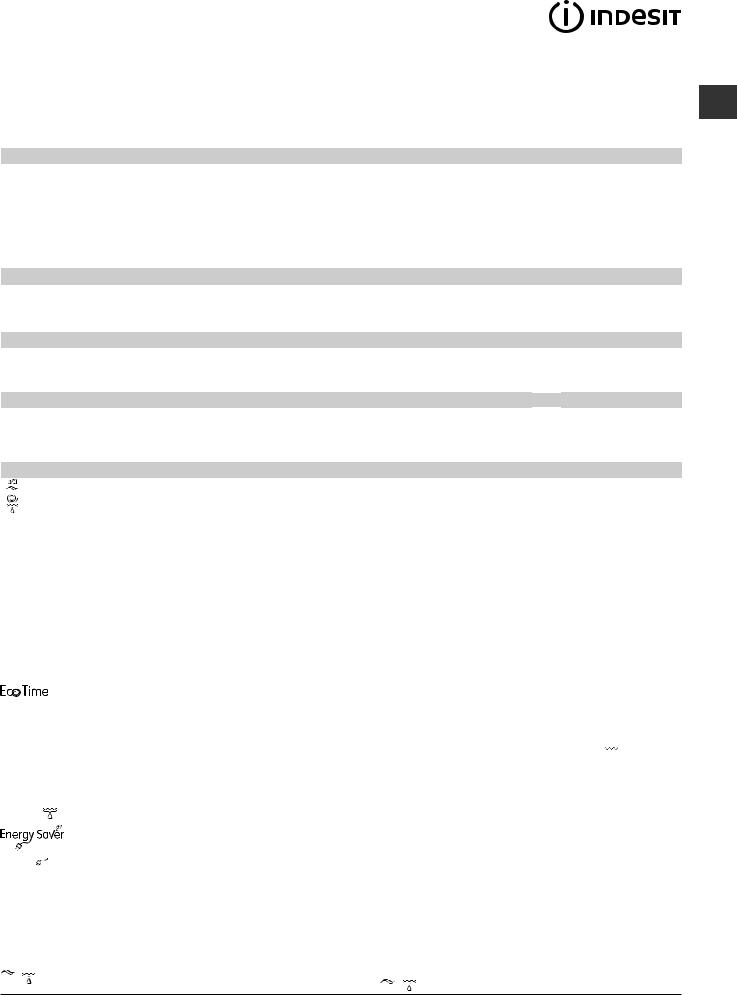
|
|
|
|
|
|
|
|
|
|
|
|
|
|
|
|
|
|
|
|
|
|
|
|
Wash cycles |
|
Max. |
Max. |
|
Detergents |
Max. load (kg) |
Residual dampness % |
Energy consumption kWh |
Total water lt |
Cycle duration |
|
|
|
|
|
||||||||
Description of the wash cycle |
temp. |
speed |
|
|
|
||||||
|
(°C) |
(rpm) |
Pre- |
Wash |
Fabric |
||||||
|
|
|
wash |
softener |
|||||||
|
|
|
|
|
|
||||||
|
|
|
|
|
|
|
|
|
|
|
|
|
Daily |
|
|
|
|
|
|
|
|
|
|
1 |
Cotton with prewash: extremely soiled whites. |
90° |
1000 |
|
|
|
6 |
6 |
2,18 |
75 |
170’ |
2 |
Cotton Standard 60° (1): heavily soiled whites and resistant colours. |
60° |
1000 |
- |
|
|
6 |
62 |
1,03 |
49 |
190’ |
(Max. 90°) |
|||||||||||
3 |
Cotton Standard 40° (2): lightly soiled whites and delicate colours. |
40° |
1000 |
- |
|
|
6 |
62 |
1,09 |
92 |
180’ |
4 |
Synthetics: heavily soiled resistant colours. |
60° |
800 |
- |
|
|
3,5 |
44 |
0,93 |
47 |
115’ |
4 |
Synthetics (3): lightly soiled resistant colours. |
40° |
800 |
- |
|
|
3,5 |
44 |
0,57 |
46 |
100’ |
5 |
Mix Colored: lightly soiled whites and delicate colours. |
40° |
1000 |
- |
|
|
6 |
62 |
0,60 |
50 |
85’ |
|
20° Zone |
|
|
|
|
|
|
|
|
|
|
|
|
|
|
|
|
|
|
|
|
|
|
6 |
Cotton Standard 20°: lightly soiled whites and delicate colours. |
20° |
1000 |
- |
|
|
6 |
- |
- |
- |
170’ |
7 |
Mix Light |
20° |
800 |
- |
|
|
6 |
- |
- |
- |
120’ |
8 |
20’ Refresh |
20° |
800 |
- |
|
|
1,5 |
- |
- |
- |
20’ |
|
Special |
|
|
|
|
|
|
|
|
|
|
9 |
Silk/Curtains: for garments in silk and viscose, lingerie. |
30° |
0 |
- |
|
|
1 |
- |
- |
- |
55’ |
10 |
Wool: for wool, cashmere, etc. |
40° |
800 |
- |
|
|
1,5 |
- |
- |
- |
70’ |
11 |
Jeans |
40° |
800 |
- |
|
|
3 |
- |
- |
- |
75’ |
|
Sport |
|
|
|
|
|
|
|
|
|
|
12 |
Sport Intensive |
30° |
600 |
- |
|
|
3 |
- |
- |
- |
85’ |
13 |
Sport Light |
30° |
600 |
- |
|
|
3 |
- |
- |
- |
60’ |
14 |
Sport Shoes |
30° |
600 |
- |
|
|
Max. 2 |
- |
- |
- |
60’ |
|
|
|
|
|
|
|
Pairs |
|
|
|
|
|
Partial wash cycles |
|
|
|
|
|
|
|
|
|
|
|
Rinse |
- |
1000 |
- |
- |
|
6 |
- |
- |
- |
36’ |
|
Spin + Drain |
- |
1000 |
- |
- |
- |
6 |
- |
- |
- |
16’ |
|
|
|
|
|
|
|
|
|
|
|
|
The length of cycle shown on the display or in this booklet is an estimation only and is calculated assuming standard working conditions. The actual duration can vary according to factors such as water temperature and pressure, the amount of detergent used, the amount and type of load inserted, load balancing and any wash options selected.
1) Test wash cycle in compliance with directive 1061/2010: set wash cycle 2 with a temperature of 60°C.
This cycle is designed for cotton loads with a normal soil level and is the most efficient in terms of both electricity and water consumption; it should be used for garments which can be washed at 60°C. The actual washing temperature may differ from the indicated value.
2) Test wash cycle in compliance with directive 1061/2010: set wash cycle 3 with a temperature of 40°C.
This cycle is designed for cotton loads with a normal soil level and is the most efficient in terms of both electricity and water consumption; it should be used for garments which can be washed at 40°C. The actual washing temperature may differ from the indicated value.
For all Test Institutes:
2)Long wash cycle for cottons: set wash cycle 3 with a temperature of 40°C.
3)Synthetic program along: set wash cycle 4 with a temperature of 40°C.
Wash options
Selecting this option enables you to suitably adjust drum rotation, temperature and water to a reduced load of lightly soiled cotton and synthetic fabrics (refer to the “Programme table”). “


 ” enables you to wash in less time thereby saving water and electricity. We suggest using a liquid detergent suitably measured out to the load quantity.
” enables you to wash in less time thereby saving water and electricity. We suggest using a liquid detergent suitably measured out to the load quantity.
! It cannot be used with the 1, 6, 7, 8, 9, 10, 11, 12, 13, 14,  ,
,  programmes.
programmes.
The 




 function saves energy by not heating the water used to wash your laundry - an advantage both to the environment and to your energy bill. Instead, intensified wash action and water optimisation ensure great wash results in the same average time of a standard cycle.
function saves energy by not heating the water used to wash your laundry - an advantage both to the environment and to your energy bill. Instead, intensified wash action and water optimisation ensure great wash results in the same average time of a standard cycle.
For the best washing results we recommend the usage of a liquid detergent.
! It cannot be used with the 1, 6, 7, 8, 9, 10, 12, 13, 14,  ,
,  programmes.
programmes.


 Extra Rinse
Extra Rinse
By selecting this option, the efficiency of the rinse is increased and optimal detergent removal is guaranteed. It is particularly useful for sensitive skin.
! It cannot be used in conjunction with the 8,  programmes.
programmes. 
 Easy Iron
Easy Iron
By selecting this function, the wash and spin cycles will be modified in order to reduce the formation of creases. At the end of the cycle the washing machine will perform slow rotations of the drum; the indicator lights for the EASY IRON and START/PAUSE options will flash (the first one green, the second orange). To end the cycle, press the START/ PAUSE button or the EASY IRON button. For the 9 wash cycle, the machine will end the cycle while the laundry is soaking and the EASY IRON and START/PAUSE indicator lights will flash. To drain the water so that the laundry may be removed, press the START/PAUSE button or the EASY IRON button.
! It cannot be used in conjunction with the 8, 10, 12, 13, 14,  ,
,  programmes.
programmes.
9
GB
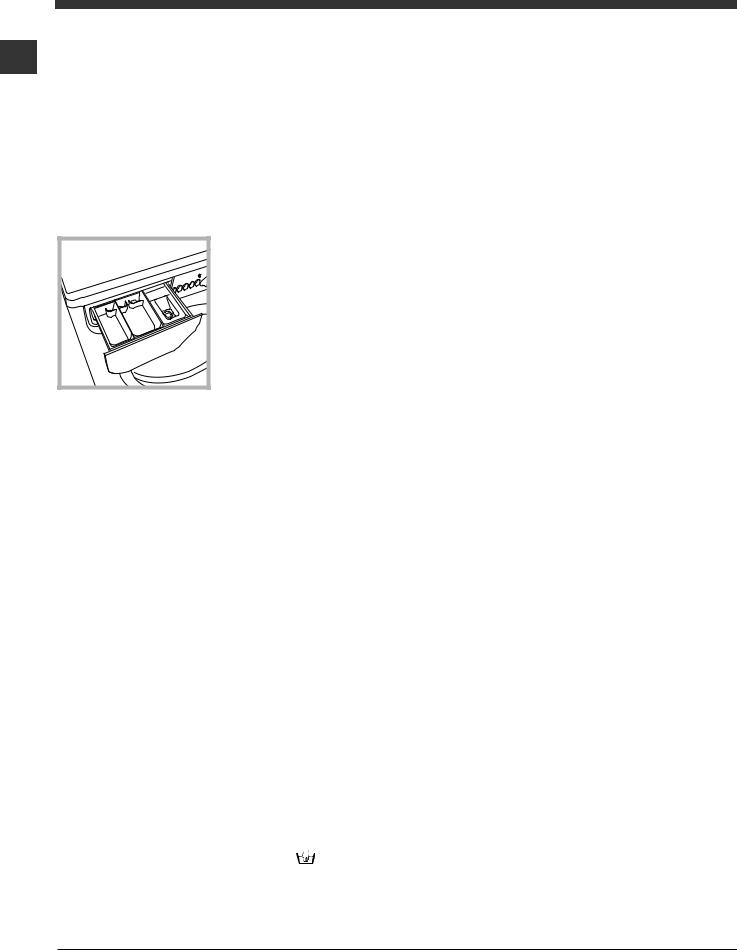
Detergents and laundry
Detergent dispenser drawer
GB Good washing results also depend on the correct dose of detergent: adding too much detergent will not necessarily result in a more efficient wash, and may in fact cause build up on the inside of your appliance and contribute to environmental pollution.
!Do not use hand washing detergents because these create too much foam.
!Use powder detergent for white cotton garments, for prewashing, and for washing at temperatures over 60°C.
!Follow the instructions given on the detergent packaging.
1 |
2 |
3 |
Open the detergent dispenser drawer and pour in the detergent or washing additive, as follows.
compartment 1: Pre-wash detergent (powder) compartment 2: Detergent for the wash cycle (powder or liquid)
Liquid detergent should only be poured in immediately prior to the start of the wash cycle.
compartment 3: Additives (fabric softeners, etc.)
The fabric softener should not overflow the grid.
Preparing the laundry
•Divide the laundry according to:
-the type of fabric/the symbol on the label
-the colours: separate coloured garments from whites.
•Empty all garment pockets and check the buttons.
•Do not exceed the values listed in the “Table of wash cycles”, which refer to the weight of the laundry when dry.
How much does your laundry weigh?
1 sheet 400-500 g
1 pillow case 150-200 g
1 tablecloth 400-500 g
1 bathrobe 900-1200 g
1 towel 150-250 g
Sport Intensive (programma 12): is for washing heavily soiled sports clothing fabrics (tracksuits, shorts, etc.); for best results, we recommend not exceeding the maximum load indicated in the “Programme table”.
Sport Light (programma 13): is for washing lightly soiled sports clothing fabrics (tracksuits, shorts, etc.); for best results, we recommend not exceeding the maximum load indicated in the “Programme table”. We recommend using a liquid detergent and dosage suitable for a half-load.
Special Shoes (programma 14): is for washing sports shoes; for best results, do not wash more than 2 pairs simultaneously.
The 20° wash cycles (20° Zone) offer effective washing performance at low temperatures, reducing electricity usage and expenditure while benefitting the environment. The 20° wash cycles meet all requirements:
Cotton Standard 20° (programme 6) ideal for heavily soiled cotton loads. The effective performance levels achieved at cold temperatures, which are comparable to washing at 40°, are guaranteed by a mechanical action which operates at varying speed, with repeated and frequent peaks.
Mix Light (programme 7) ideal for mixed loads (cotton and synthetics) with a normal soil level. The effective performance levels achieved at cold temperatures are guaranteed by a mechanical action which operates at varying speed, across set average intervals.
20’ Refresh (programme 8) ideal for refreshing and washing lightly soiled garments in a few minutes. It lasts just 20 minutes and therefore saves both time and energy. It can be used to wash different types of fabrics together (except for wool and silk), with a maximum load of 1.5 kg.
Load balancing system
Before every spin cycle, to avoid excessive vibrations and to distribute the load in a uniform manner, the drum rotates continuously at a speed which is slightly greater than the washing rotation speed. If, after several attempts, the load is not balanced correctly, the machine spins at a reduced spin speed. If the load is excessively unbalanced, the washing machine performs the distribution process instead of spinning. To encourage improved load distribution and balance, we recommend small and large garments are mixed in the load.
Special wash cycles
Silk: use special wash cycle 9 to wash all silk garments. We recommend the use of special detergent which has been designed to wash delicate clothes.
Curtains: fold curtains and place them in a pillow case or
mesh bag. Use wash cycle 9.
Wool: all wool garments can be washed using programme 10, even those carrying the “hand-wash only” label. For best results, use special detergents and do not exceed 1,5 kg of laundry.
Jeans: Turn garments inside-out before washing and use a liquid detergent. Use programme 11.
10

Troubleshooting
Your washing machine could fail to work. Before contacting the Technical Assistance Centre (see “Assistance”), make sure |
GB |
that the problem cannot be solved easily using the following list. |
Problem:
The washing machine does not switch on.
The wash cycle does not start.
The washing machine does not take in water (“H2O” will flash on the display).
Possible causes / Solutions:
•The appliance is not plugged into the socket fully, or is not making contact.
•There is no power in the house.
•The washing machine door is not closed properly.
•The ON/OFF button has not been pressed.
•The START/PAUSE button has not been pressed.
•The water tap has not been opened.
•A delayed start has been set..
•The water inlet hose is not connected to the tap.
•The hose is bent.
•The water tap has not been opened.
•There is no water supply in the house.
•The pressure is too low.
•The START/PAUSE button has not been pressed.
The washing machine continuously takes in and
drains water.
•The drain hose is not fitted at a height between 65 and 100 cm from the floor (see “Installation”).
•The free end of the hose is under water (see “Installation”).
•The wall drainage system is not fitted with a breather pipe.
If the problem persists even after these checks, turn off the water tap, switch the appliance off and contact the Assistance Service. If the dwelling is on one of the upper floors of a building, there may be problems relating to water drainage, causing the washing machine to fill with water and drain continuously. Special anti-draining valves are available in shops and help to avoid this inconvenience.
The washing machine does not drain or spin.
•The wash cycle does not include draining: some wash cycles require the drain phase to be started manually.
•The “Easy iron” option has been activated: To complete the wash cycle, press the START/PAUSE button (see “Wash cycles and options”).
•The drain hose is bent (see “Installation”).
•The drainage duct is clogged.
The washing machine vibrates a lot during the spin cycle.
The washing machine leaks.
•The drum was not unlocked correctly during installation (see “Installation”).
•The washing machine is not level (see “Installation”).
•The washing machine is trapped between cabinets and walls (see “Installation”).
•The water inlet hose is not screwed on properly (see “Installation”).
•The detergent dispenser drawer is blocked (for cleaning instructions, see “Care and maintenance”).
•The drain hose is not fixed properly (see “Installation”).
The “option” indicator lights and the “start/pause” indicator light flash and an error code appears on the display (e.g.: F-01, F-..).
There is too much foam.
•Switch off the machine and unplug it, wait for approximately 1 minute and then switch it back on again.
If the problem persists, contact the Technical Assistance Service.
•The detergent is not suitable for machine washing (it should display the text “for washing machines” or “hand and machine wash”, or the like).
•Too much detergent was used.
11

Service
|
|
|
|
|
|
Before calling for Assistance: |
|
GB |
|||
|
• Check whether you can solve the problem alone (see “Troubleshooting”); |
||
|
|
||
|
|
• Restart the programme to check whether the problem has been solved; |
|
|
|||
|
|
• If this is not the case, contact an authorised Technical Assistance Centre using the telephone number provided on the |
|
|
|
guarantee certificate. |
|
|
|
! Always request the assistance of authorised technicians. |
Have the following information to hand:
•the type of problem;
•the appliance model (Mod.);
•the serial number (S/N).
This information can be found on the data plate applied to the rear of the washing machine, and can also be found on the front of the appliance by opening the door.
12

Návod na použitie
SK
Slovensky
IWE 61051
PRÁČKA
Obsah |
SK |
|
Inštalácia, 14-15
Rozbalenie a vyrovnanie do vodorovnej polohy
Pripojenie k elektrickej a k vodovodnej sieti
Prvý prací cyklus
Technické údaje
Údržba a starostlivosť, 16
Uzavretie prívodu vody a vypnutie elektrického napájania Čistenie práčky
Čistenie dávkovača pracích prostriedkov Starostlivosť o dvierka a bubon Čistenie čerpadla
Skontrolujte prítokovú hadicu vodu
Opatrenia a rady, 17
Základné bezpečnostné pokyny
Likvidácia
Manuálne otvorenie dvierok
Popis práčky, 18-19
Ovládací panel
Displej
Ako vykonať prací cyklus, 20
Programy a funkcie, 21
Tabuľka pracích programov Funkcie prania
Pracie prostriedky a prádlo, 22
Dávkovač pracích prostriedkov Príprava prádla
Špeciálne programy
Systém automatického vyváženia náplne
Poruchy a spôsob ich odstránenia, 23 Servisná služba, 24
13

Inštalácia
! Je veľmi dôležité uschovať tento návod SK kvôli prípadnému ďalšiemu použitiu. V prípa-
de predaja, darovania alebo presťahovania práčky sa uistite, že zostane uložený v jej blízkosti, aby mohol poslúžiť novému majiteľovi pri oboznámení sa s činnosťou a s príslušnými upozorneniami.
! Pozorne si prečítajte uvedené pokyny: obsahujú dôležité informácie, týkajúce sa inštalácie, použitia a bezpečnosti pri práci.
Rozbalenie a vyrovnanie do vodorovnej polohy
Rozbalenie
1. Rozbaľte práčku.
2. Skontrolujte, či počas prepravy nedošlo k jej poškodeniu. V prípade, že je poškodená, nezapájajte ju a obráťte sa na predajcu.
3. Odstráňte 4 skrutky slúžiace
na ochranu počas
prepravy a gumovú podložku
s príslušným
dištančným členom,
ktoré sa nachádzajú
v zadnej časti (viď
obrázok).
4.Uzatvorte otvory po skrutkách plastovými krytkami z príslušenstva.
5.Uschovajte všetky diely: v prípade opätovnej prepravy práčky ich bude potrebné opätovne namontovať.
! Obaly nie sú hračky pre deti!
Vyrovnanie do vodorovnej polohy
1. Práčku je potrebné umiestniť na rovnú a pevnú podlahu tak, aby nebola opretá o stenu, nábytok alebo o niečo iné.
2. V prípade, že podlaha nie je dokonale vodorovná, môžu byť prípadné
rozdiely vykompenzované skrutkovaním predných nožičiek
(viď obrázok); Uhol sklonu, nameraný na pracovnej ploche, nesmie presiahnuť 2°.
Dokonalé vyrovnanie do vodorovnej polohy zabezpečí stabilitu zariadenia a zamedzí vzniku vibrácií a hluku počas činnosti. V prípade inštalácie na podlahovú krytinu alebo na koberec, nastavte nožičky tak, aby pod práčkou zostal dostatočný voľný priestor na ventiláciu.
Pripojenie k elektrickej a k vodovodnej sieti
Pripojenie prítokovej hadice vody
1. Pripojte prívodnú hadicu jej zaskrutkovaním ku kohútiku so studenou vody s hrdlom so závitom
3/4“ (viď obrázok).
Pred pripojením hadice nechajte vodu odtiecť, až kým nebude číra.
2. Pripojte prítokovú hadicu k pračke, jej zaskrutkovaním k príslušnej prípojke na vodu, umiestnenej vpravo hore (viď obrázok).
3. Zabezpečte, aby hadica nebola príliš ohnutá alebo stlačená.
!Tlak v rozvode vody sa musí pohybovať v rozmedzí hodnôt uvedených v tabuľke s technickými údajmi (viď vedľajšia strana).
!V prípade, že dĺžka prítokovej hadice nebude dostatočná, obráťte sa na špecializovanú predajňu alebo na autorizovaný technický personál.
!Nikdy nepoužívajte už použité hadice.
!Používajte hadice z príslušenstva zariadenia.
14
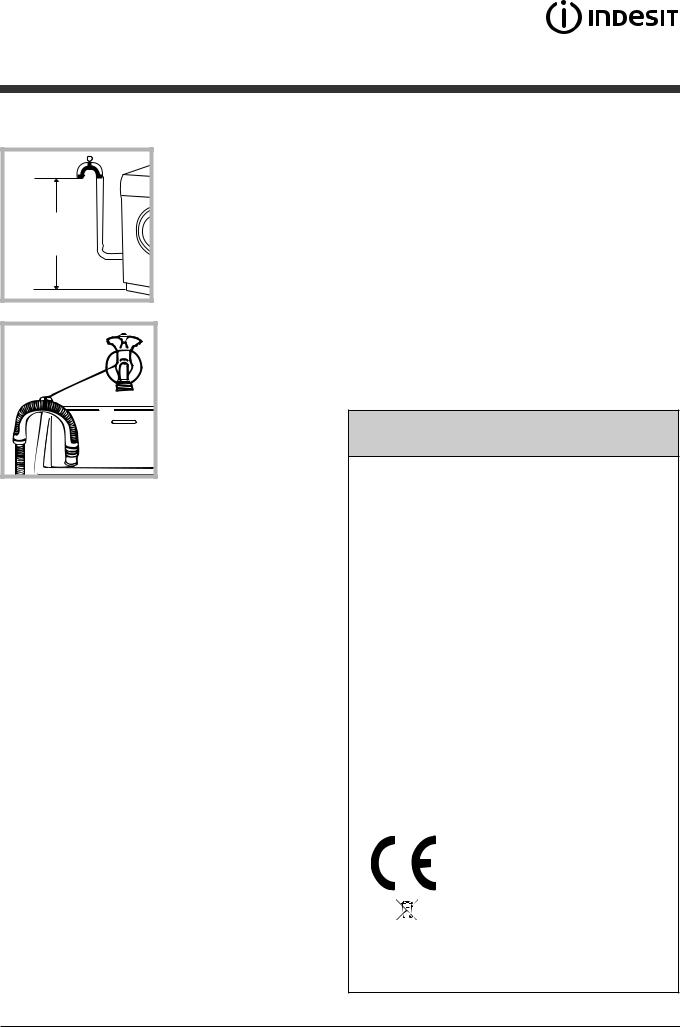
Pripojenie vypúšťacej hadice
65 - 100 cm |
Pripojte vypúšťaciu hadicu, bez toho aby ste ju ohli, k odpadovému potrubiu alebo k odpadu v stene, ktorý sa nachádza od 65 do 100 cm nad zemou;
alebo ju uchyťte k
okraju umývadla
či vane, a pripev-
nite vodiaci držiak
z príslušenstva ku
kohútu (viď obrá-
zok). Voľný koniec
vypúšťacej hadice
nesmie zostať pono-
rený do vody.
! Použitie predlžovacích hadíc sa neodporúča; ak je však nevyhnutné, predlžovacia hadica musí mať rovnaký priemer ako originálna hadica a jej dĺžka nesmie presiahnuť 150 cm.
Pripojenie k elektrickej sieti
Pred zasunutím zástrčky do zásuvky sa uistite, že:
•zásuvka je uzemnená a že vyhovuje normám;
•zásuvka je schopná uniesť maximálnu záťaž odpovedajúcu menovitému príkonu zariadenia, uvedenému v tabuľke s technickými údajmi (viď vedľa);
•hodnota napájacieho napätia odpovedá údajom uvedeným v tabuľke s technickými údajmi (viď vedľa);
•zásuvka je kompatibilná so zástrčkou práčky. V opačnom prípade je potrebné vymeniť zásuvku alebo zástrčku.
!Práčka nesmie byť umiestnená vonku – pod holým nebom, a to ani v prípade, keby sa jednalo o miesto chránené pred nepriazňou počasia, pretože je veľmi nebezpečné vystaviť ju dažďu a búrkam.
!Po ukončení inštalácie musí zásuvka zostať
ľahko prístupná.
! Nepoužívajte predlžovacie káble a rozvodky. |
|
SK |
|
! Kábel nesmie byť ohnutý alebo pritlačený. |
|
! Výmena kábla musí byť zverená výhradne |
|
autorizovanému technickému personálu. |
|
Upozornenie! Výrobca neponesie žiadnu |
|
zodpovednosť za následky spôsobené |
|
nerešpektovaním týchto pokynov. |
|
Prvý prací cyklus |
|
Po inštalácii zariadenia je potrebné ešte pred |
|
jeho použitím vykonať jeden skúšobný cyklus |
|
s pracím prostriedkom a bez náplne prádla, |
|
nastavením pracieho programu 2. |
|
Technické údaje
Model |
IWE 61051 |
|||
|
|
|
šírka 59,5 cm |
|
Rozmery |
výška 85 cm |
|||
|
|
|
hlbka 53,5 cm |
|
Kapacita |
od 1 do 6 kg |
|||
Elektrické |
Viï štítok s technickými |
|||
údajmi, aplikovaný na za- |
||||
zapojeni |
||||
riadení. |
||||
|
|
|
||
|
|
|
maximálny tlak |
|
Pripojenie k |
1 MPa (10 bar) |
|||
maximálny tlak |
||||
rozvodu vody |
||||
0,05 MPa (0.5 bar) |
||||
|
|
|
kapacita bubna 52 litrov |
|
Rýchlos |
a do 1000 otáèok za minútu |
|||
odstrd`ovania |
||||
Kontrolné |
Program 2: štandardný pro- |
|||
programy |
||||
gram pre bavlnu pri 60°C. |
||||
podľa smerníc |
||||
Program 3: štandardný pro- |
||||
1061/2010 a |
gram pre bavlnu pri 40°C. |
|||
1015/2010. |
|
|||
|
|
|
Toto zariadenie je v zhode |
|
|
|
|
s nasledujúcimi smernicami |
|
|
|
|
Európskej únie: |
|
|
|
|
- 2004/108/CE (Elektroma- |
|
|
|
|
gnetická kompatibilita) |
|
|
|
|
- 2006/95/CE (Nízke napätie) |
|
|
|
|
- 2002/96/CE |
|
|
|
|
||
|
|
|
||
Hluènos |
Pranie: 60 |
|||
(dB(A) re |
||||
Odstredovanie: 74 |
||||
1 pW) |
||||
|
||||
15
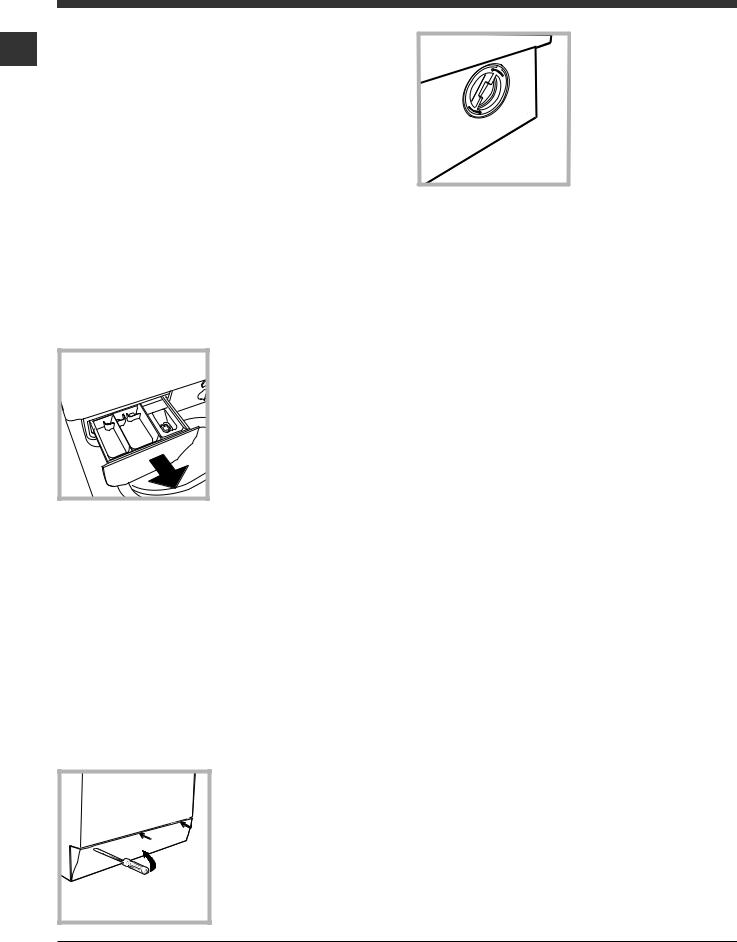
|
Údržba a starostlivosť |
|
SK |
Uzavretie prívodu vody a vypnutie |
2. odskrutkujte veko |
elektrického napájania |
otáčaním proti smeru |
|
|
|
hodinových ručičiek |
|
• Po každom praní uzatvorte prívod vody. |
(viď obrázok): |
|
Týmto spôsobom sa znižuje opotrebe- |
vytečenie malého |
|
nie rozvodu vody zariadenia a znížuje sa |
množstva vody je |
|
nebezpečenstvo úniku vody. |
úplne bežným javom; |
|
• Pred zahájením čistenia práčky a počas |
|
|
údržby je potrebné vytiahnuť zástrčku |
|
|
prívodného kábla zo zásuvky. |
|
|
Čistenie práčky |
3. dokonale vyčistite vnútro; |
|
|
4. nasaďte naspäť veko; |
|
Vonkajšie časti a časti z gumy môžu byť |
5. namontujte naspäť krycí panel, pričom |
|
čistené utierkou navlhčenou vo vlažnej vode |
sa pred jeho prisunutím k práčke uistite, že |
|
a saponáte. Nepoužívajte rozpúšťadlá alebo |
došlo k správnemu zachyteniu háčikov do |
|
abrazívne prostriedky. |
príslušných otvorov. |
|
Čisteniedávkovačapracíchprostriedkov |
Skontrolujte prítokovú hadicu vodu |
|
Vytiahnite dávkovač |
|
|
Stav prítokovej hadice je potrebné |
|
|
jeho nadvihnutím a |
|
|
vytiahnutím smerom |
skontrolovať aspoň raz ročne. Ak sú na nej |
|
von (viď obrázok). |
viditeľné praskliny alebo trhliny, je potrebné |
|
Dávkovač umyte pod |
ju vymeniť: silný tlak v hadici počas pracieho |
|
prúdom vody; toto |
cyklu by mohol spôsobiť jej náhle roztrhnutie. |
|
čistenie je potrebné |
! Nikdy nepoužívajte už použité hadice. |
|
vykonávať pravidel- |
|
|
ne. |
|
|
Starostlivosť o dvierka a bubon |
|
|
• Dvierka ponechajte zakaždým pootvorené, |
|
|
aby sa zabránilo tvorbe nepríjemných |
|
|
zápachov. |
|
|
Čistenie čerpadla |
|
|
Súčasťou práčky je samočistiace čerpadlo, |
|
|
ktoré nevyžaduje údržbu. Môže sa však |
|
|
stať, že sa v jeho vstupnej ochrannej časti, |
|
|
nachádzajúcej na spodku, zachytia drobné |
|
|
predmety (mince, gombíky). |
|
|
! Uistite sa, že prací cyklus bol ukončený a |
|
|
vytiahnite zástrčku zo zásuvky. |
|
|
Prístup k vstupnej |
|
|
časti čerpadla: |
|
|
1. pomocou |
|
|
skrutkovača |
|
|
odstráňte krycí pa- |
|
|
nel, nachádzajúci |
|
|
sa v prednej časti |
|
|
práčky |
|
|
(viď obrázok); |
|
|
16 |
|
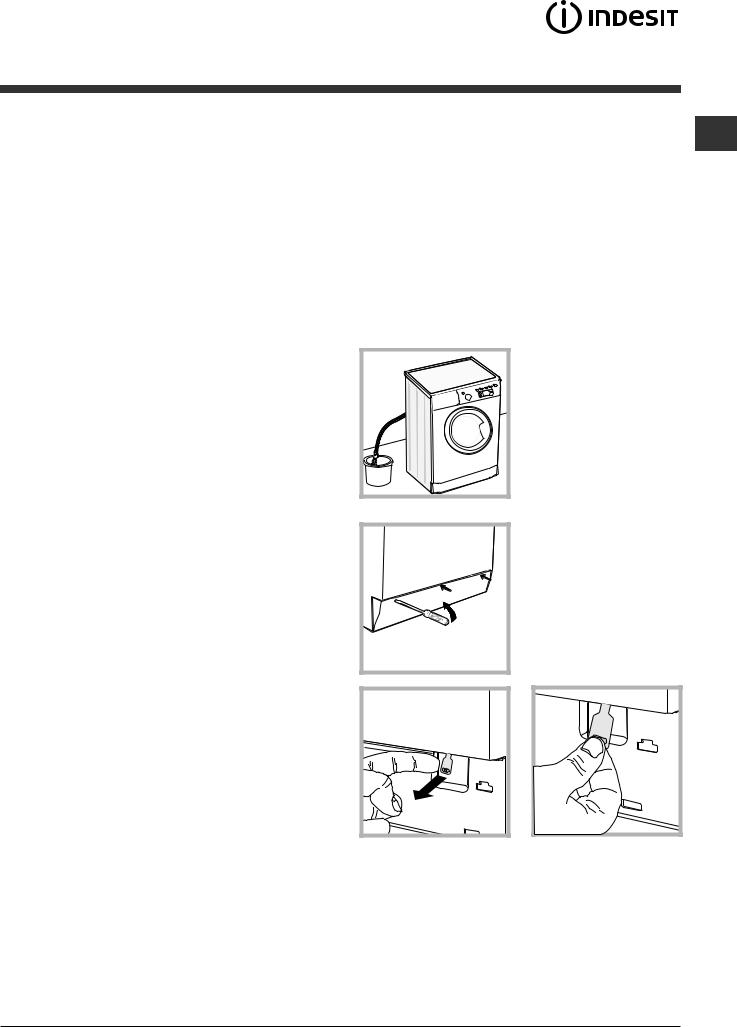
Opatrenia a rady
! Práčka bola navrhnutá a vyrobená v súlade s platnými medzinárodnými bezpečnostnými predpismi. Tieto upozornenia sú uvádzané z bezpečnostných dôvodov a je potrebné si ich pozorne prečítať.
Základné bezpečnostné pokyny
• Toto zariadenie bolo navrhnuté výhradne na použitie ako spotrebič.
• Toto zariadenie smú používať deti od 8 rokov, osoby náležite vyškolené ohľadne bezpečného použitia zariadenia, ktoré si uvedomujú súvisiace
nebezpečenstvo a v prípade dozoru aj osoby so zníženými fyzickými, senzorickými alebo duševnými schopnosťami alebo osoby s nedostatočnými skúsenosťami a znalosťami. Deti sa so zariadením nesmú hrať. Operácie údržby a čistenia nesmú vykonávať deti bez dohľadu.
•Práčku môžu používať len dospelé osoby, podľa pokynov uvedených v tomto návode.
•Nedotýkajte sa zariadenia bosí, alebo v prípade, keď máte mokré ruky alebo nohy.
•Nevyťahujte zástrčku zo zásuvky ťahaním za kábel, ale uchopením za zástrčku.
•Neotvárajte dávkovač pracích prostriedkov počas činnosti zariadenia.
•Nedotýkajte sa odčerpávanej vody, pretože môže mať veľmi vysokú teplotu.
•V žiadnom prípade sa nepokúšajte o násilné otvorenie dvierok: mohlo by dôjsť k poškodeniu bezpečnostného uzáveru, ktorý zabraňuje náhodnému otvoreniu.
•Pri výskyte poruchy sa v žiadnom prípade nepokúšajte o opravu vnútorných častí zariadenia.
•Vždy majte pod kontrolou deti a zabráňte tomu, aby sa približovali k zariadeniu počas pracieho cyklu.
•Počas pracieho cyklu majú dvierka tendenciu zohrievať sa.
•Ak je potrebné ju presunúť, je dobré poveriť dve alebo tri osoby a vykonať to s maximálnou pozornosťou. Nikdy sa nepokúšajte zariadenie premiestňovať sami, pretože je veľmi ťažké.
•Pred zahájením vkladania prádla skontrolujte, či je bubon prázdny.
Likvidácia
•Likvidácia obalových materiálov: pri ich odstránení postupujte v súlade s miestnymi predpismi a dbajte na možnú recykláciu.
•Európska smernica 2002/96/EC o odpadových elektrických a elektronických zariadeniach stanovuje, že staré domáce elektrické spotrebiče nesmú byť odkladané do běžného netriedeného domového odpadu. Staré spotrebiče musia byť odovzdané do oddeleného zberu a to za účelom recykláce a optimálneho využitia materiálov, ktoré obsahujú, z dôvodu prevencie ne-
gatívneho dopadu na ľudské zdravie a životné pro-
stredie. Symbol “prečiarknutej popolnice” na výrobku SK Vás upozorňuje na povinnosť odovzdať zariadenie po skončení jeho životnosti do oddeleného zberu.
Spotrebitelia majú povinnosť kontaktovať ich lokálny úrad alebo maloobchod kvôli informáciám týkajúcich sa správnemu odovzdaniu a likvidácie ich starých spotrebičov.
Manuálne otvorenie dvierok
V prípade, ak nie je možné otvoriť dvierka z dôvodu výpadku elektrickej energie a chceli by ste vybrať prádlo, postupujte nasledovne:
1. vytiahnite zástrčku zo zásuvky elektrickej siete. 2. Skontrolujte, či je hladina vody vo vnútri zariadenia nižšia ako je úroveň otvorenia dvierok; ak nie je, vypusťte prebytočnú vodu vypúšťacou hadicou a zachyťte ju do vedra, ako je znázornené na obrázku.
3. pomocou skrutkovača odstráňte krycí panel nachádzajúci sa v prednej časti práčky (viď obrázok).
4.pomocou jazýčka, označeného na obrázku, potiahnite plastové tiahlo smerom von z dorazu, až kým sa neuvolní; následne ho potiahnite smerom dolu a súčasne otvorte dvierka.
5.namontujte naspäť krycí panel, pričom sa pred jeho prisunutím k práčke uistite, že došlo k správnemu zachyteniu háčikov do príslušných otvorov.
17
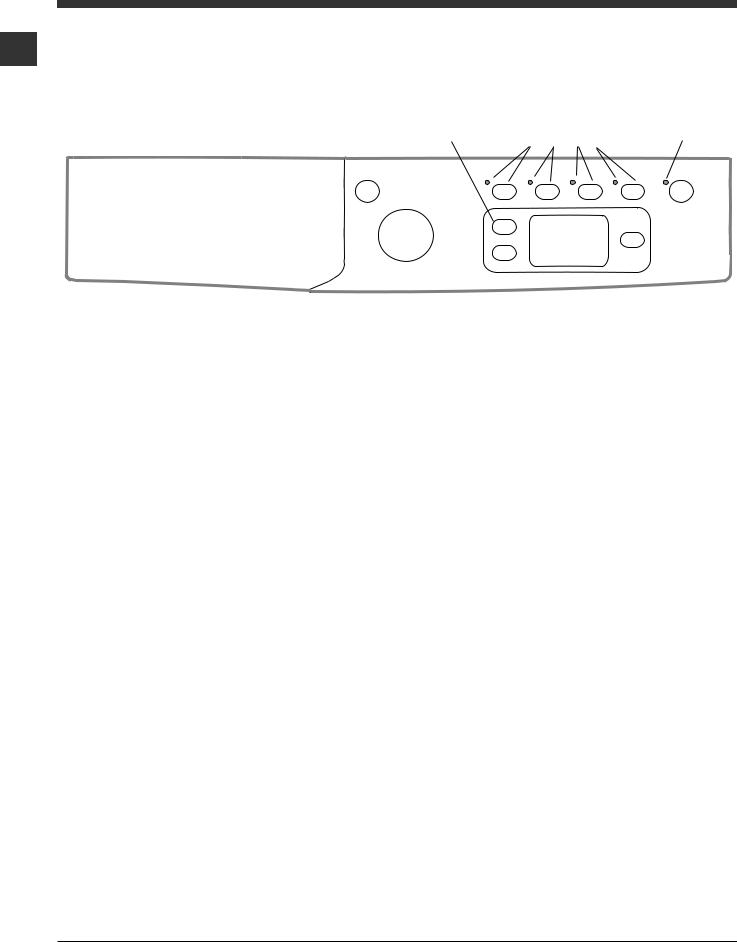
Popis práčky
SK |
Ovládací panel |
|
Tlačidlo |
|
Tlačidlo |
FUNKČNÉ |
Tlačidlo s kontrolkou |
|
|
|||||
ON/OFF |
|
TEPLOTY |
tlačidlá s kontrolkami |
START/PAUSE |
|
|
|
|
|
|
|
Displej
|
|
|
|
|
|
|
|
|
|
|
|
|
|
|
|
|
|
|
|
|
|
|
|
Dávkovač pracích |
|
|
|
Tlačidlo |
|
||
|
Tlačidlo |
|
|||||
prostriedkov |
Otočný ovládač PRO- |
ONESKORENÉHO |
|||||
ODSTREĎOVANIA |
|||||||
|
|
GRAMOV |
|
|
ŠTARTU |
||
|
|
|
|
||||
Dávkovač pracích prostriedkov: slúži na dávkovanie pracích prostriedkov a prídavných prostriedkov (viď „Pracie prostriedky a prádlo“).
Tlačidlo ON/OFF  : zapnite alebo vypnite práčku krátkym stlačením tlačidla. Kontrolka START/PAUZA pomaly blikajúca zeleným svetlom signalizuje, že zariadenie je zapnuté. Ak chcete vypnúť práčku počas prania, je potrebné držať tlačidlo stlačené dlhšie, približne 3 sek.; krátkym alebo náhodným stlačením práčku nevypnete. Vypnutie zariadenia počas prania spôsobí zrušenie prebiehajúceho pracieho programu.
: zapnite alebo vypnite práčku krátkym stlačením tlačidla. Kontrolka START/PAUZA pomaly blikajúca zeleným svetlom signalizuje, že zariadenie je zapnuté. Ak chcete vypnúť práčku počas prania, je potrebné držať tlačidlo stlačené dlhšie, približne 3 sek.; krátkym alebo náhodným stlačením práčku nevypnete. Vypnutie zariadenia počas prania spôsobí zrušenie prebiehajúceho pracieho programu.
Otočný ovládač PROGRAMOV: slúžia na nastavenie požadovaného programu (viď „Tabuľka pracích programov“).
FUNKČNÉ tlačidlá s kontrolkami: Slúžia na voľbu jednotlivých dostupných funkcií. Kontrolka zvolenej funkcie zostane rozsvietená.
Tlačidlo ODSTREĎOVANIA  : stlačte kvôli zníženiu alebo úplnému vylúčeniu odstreďovania - hodnota bude uvedená na displeji.
: stlačte kvôli zníženiu alebo úplnému vylúčeniu odstreďovania - hodnota bude uvedená na displeji.
Tlačidlo TEPLOTY  : stlacte pre zníženie teploty: príslušná hodnota bude zobrazená na displeji.
: stlacte pre zníženie teploty: príslušná hodnota bude zobrazená na displeji.
Tlačidlo ONESKORENÉHO ŠTARTU  : stlačte za účelom nastavenia oneskoreného štartu zvoleného programu. Doba, o ktorú bude štart oneskorený, bude zobrazená na displeji.
: stlačte za účelom nastavenia oneskoreného štartu zvoleného programu. Doba, o ktorú bude štart oneskorený, bude zobrazená na displeji.
Tlačidlo s kontrolkou START/PAUSE 
 : keď zelená kontrolka začne pomaly blikať, stlačte tlačidlo, aby ste zahájili pranie. Po zahájení cyklu sa kontrolka rozsvieti stálym svetlom. Ak si želáte prerušiť pranie, opätovne stlačte tlačidlo; kontrolka bude blikať oranžovým svetlom. Ak symbol
: keď zelená kontrolka začne pomaly blikať, stlačte tlačidlo, aby ste zahájili pranie. Po zahájení cyklu sa kontrolka rozsvieti stálym svetlom. Ak si želáte prerušiť pranie, opätovne stlačte tlačidlo; kontrolka bude blikať oranžovým svetlom. Ak symbol  nie je podsvietený bude možné otvoriť dvierka. Aby ste opätovne spustili cyklus od doby, kedy bol prerušený, opätovne stlačte tlačidlo.
nie je podsvietený bude možné otvoriť dvierka. Aby ste opätovne spustili cyklus od doby, kedy bol prerušený, opätovne stlačte tlačidlo.
Pohotovostný režim
Kvôli zhode s novými predpismi súvisiacimi s energetickou úsporou, je táto práčka vybavená systémom automatického vypnutia (prechodu do pohotovostného režimu – standby), ktorý je aktivovaný po uplynutí 30 minút, ak práčka nie je používaná. Krátko stlačte tlačidlo ON/OFF a vyčkajte na obnovenie činnosti zariadenia.
Spotreba v off-mode: 0,5 W Spotreba v Left-on: 0,5 W
18
